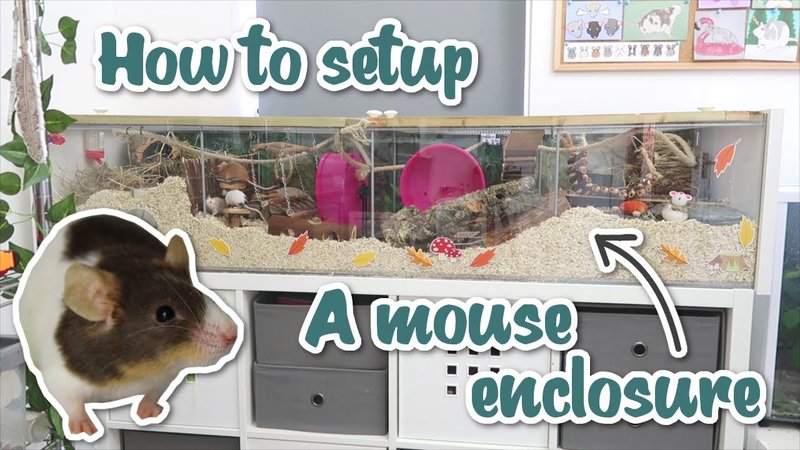
Their needs can be a little different from your average pet. So, if you’re wondering how to create the best living environment, what food to get, and how to keep your little friend stimulated, you’re in the right place. Let’s dive in and explore the ins and outs of caring for a frizzie mouse!
Cage Setup: Creating a Cozy Home
When setting up a cage for your frizzie mouse, think of it as creating their own little kingdom. You’ll want to choose a spacious cage where they can explore, play, and relax. A multi-level cage is often the best option because it maximizes vertical space. Look for a cage at least 24 inches tall with small bar spacing—about ¼ inch apart—to keep your little buddy safe.
Once you’ve picked out the right cage, it’s time to add some bedding. Aspen shavings or paper-based bedding works well. Avoid cedar or pine shavings, as they can be harmful to your mouse’s respiratory system. A layer of bedding that’s about an inch thick provides a comfy place for them to burrow and nest.
Next, add a few essentials for your frizzie mouse. You’ll need a water bottle attached securely to the side of the cage, ensuring they have fresh water at all times. A small, sturdy hiding house is also a must; mice love having a cozy spot to retreat to when they need a break. Don’t forget to include exercise wheels and tunnels—these provide ample opportunities for play and movement, which are vital for their health.
Diet: What to Feed Your Frizzie Mouse
Feeding your frizzie mouse the right diet is crucial for their well-being. Think of their food as the fuel that keeps their little engines running. A balanced diet typically consists of high-quality mouse or rodent pellets. Look for ones specifically formulated for mice, as they offer the right mix of nutrients.
But don’t stop there! Variety is key to keeping your mouse happy. Offer small portions of fresh fruits and vegetables like carrots, peas, or apple slices. Just remember to introduce new foods gradually to avoid tummy troubles. You might be wondering how much to feed them—generally, about a tablespoon of pellets along with a tiny treat or two of fresh produce daily should suffice.
Also, mice love to nibble on treats! You can offer tiny bits of cheerios, oats, or even small pieces of cooked chicken once in a while. Just keep these treats to a minimum to ensure they maintain a healthy diet.
Enrichment: Keeping Your Mice Engaged
Enrichment is all about keeping your frizzie mouse mentally and physically stimulated. Just like humans, mice can get bored, which leads to stress and health issues. Think of fun activities or toys as mini-adventures for your little friend!
Start by providing various toys. You can buy commercial mouse toys, but you can also get creative! Cardboard tubes from paper towels work wonders, or you could make your own tunnels out of safe, non-toxic materials. Chewing toys can help keep their teeth healthy, as mouse teeth continuously grow.
Another great way to enrich their environment is through foraging. Hide little treats around the cage, encouraging your mouse to dig and explore. This mimics their natural behavior and keeps them active. And don’t forget about social interaction! Spend time handling your mouse gently, letting them explore your hands or the area outside their cage (supervised, of course).
Temperature and Environment: Setting the Right Atmosphere
Creating a comfortable atmosphere for your frizzie mouse is essential. They prefer a temperature range between 65°F and 75°F. Too hot or too cold can stress them out, so keep their cage in a stable environment, away from drafts or direct sunlight.
Lighting is also important. Mice are crepuscular, meaning they are most active during dusk and dawn. It’s best to keep the cage in a place where they can have some natural light but also have dark periods, which help them rest. If you notice your mouse being more active at night, that’s perfectly normal!
Make sure to keep the noise level low, as loud sounds can spook them. If you have other pets, watch your mouse’s cage placement to keep them safe from barking dogs or prowling cats.
Health and Grooming: Keeping Your Mouse in Top Shape
Making sure your frizzie mouse stays healthy is key to their happiness. Regularly checking for signs of illness is part of a good care routine. Look for changes in eating habits, energy levels, or behavior. If your mouse seems less active or not eating as much, it could signal a problem.
Grooming is less of a chore with frizzies, but it’s still important to keep an eye on their fur. They usually groom themselves pretty well, but you can help by brushing them gently if needed. This can also be a nice bonding moment! Using a small, soft-bristled brush, you can keep their coat looking neat.
Lastly, they’ll need regular veterinary check-ups, just like any other pet. Finding a veterinarian experienced with small animals is essential. Remember, preventative care is always better than having to deal with health issues later on.
Social Interaction: Bonding with Your Frizzie Mouse
Building a relationship with your frizzie mouse can be one of the most rewarding parts of being a pet owner. These little guys thrive on interaction and can become quite affectionate. When you first bring home your mouse, give them time to settle in. It might take a few days or a week for them to feel comfortable.
Start by spending time near their cage, talking gently to them. You might be surprised by how quickly they get used to your presence. After a few days, you can begin to hand-feed them treats. This encourages positive associations and makes them more comfortable with you.
Once they’re used to you, you can start handling them gently. Make sure to scoop them up from underneath, supporting their bodies well. Remember to keep handling sessions short at first—just a few minutes to avoid overwhelming them. Over time, you can gradually extend the handling time as they become more relaxed around you.
Common Challenges: Troubleshooting Care Issues
Sometimes, you might run into challenges while caring for your frizzie mouse. One common issue is if your mouse seems overly shy or scared. If so, try giving them more space and time to adjust. Another possible challenge is dealing with strong odors from their cage; this often signals that the bedding needs changing. Regular spot cleaning can help, and fully changing the bedding weekly will keep things fresh.
If your mouse has dietary issues, such as not eating enough, try varying their diet or consulting with a vet for advice. And if you notice any abnormal droppings or changes in behavior, don’t hesitate to reach out to a vet for guidance. Remember, keeping your frizzie mouse happy and healthy is a journey, and it’s perfectly okay to seek help along the way!
In conclusion, caring for a frizzie mouse is a delightful experience filled with rewards. From setting up their cozy cage and providing a balanced diet to ensuring they have plenty of enrichment, every bit of effort pays off in love and companionship. Just like any special pet, your frizzie mouse deserves the best care you can provide, creating a bond that can last a lifetime.

